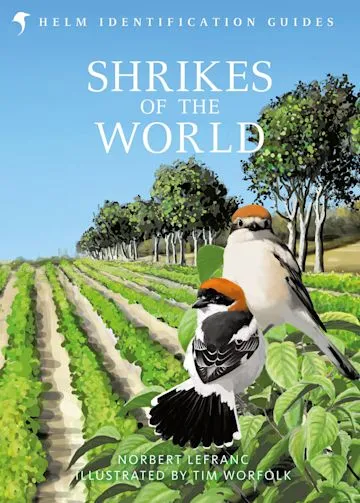
Shrikes occupy a strange place in the minds and hearts of ornithologists; at once being attractive passerines, but with a raptorial streak that led to many of us being brought up to know them as butcherbirds for their habit of impaling food items on thorns and barbed wire.
They can be a birder’s dream and nightmare, with complexes of closely intertwined species and subspecies making field identification of individuals tricky. And they are at once widespread globally, but with specific conservation requirements that that make them locally rare, as here in the UK.
Twenty-six years ago, author Norbert Lefranc and illustrator Tim Worfolk produced a labour of love with the first edition of Shrikes of the World, which became the definitive work for this multifaceted, complicated group of birds.
With a new series of stunningly detailed plates showing the full range of variation within species, and text accounts that incorporate recent advances in genetic work, the wait for the second edition has surely been worth it.
The first chapter gives a helpful introduction to the structure of the book as a whole and the individual species accounts. With a family as taxonomically knotty as shrikes, it is inevitable that some of the early chapters should concern their systematics.
Here the authors also invite Jérôme Fuchs, noted expert in shrike taxonomy, to contribute an introduction to the true shrikes; defined in the book as the genus Lanius. Yellow-billed Shrike and Magpie Shrike were previously in two genera of their own, but have recently been re-sequenced into Lanius, and the book reflects this up-to-date taxonomy.
Also included is the genus Eurocephalus, consisting of two species from Africa that recent research suggests may not even belong within the shrike family. Despite the qualms around their taxonomy, the authors have opted to keep these two species in the book, to reflect the current accepted structure of the shrike family.
Following the nitty-gritty of shrike relationships, there are general yet truly detailed accounts of the two shrike genera, filled with rich descriptions of their history, morphology, migration, habitat, and more, and includes a particularly enjoyable section on their food storage behaviour, with suitably gruesome illustrations.
The colour plates are simply spectacular, with the illustrations being almost photographic in their detail. The species accounts follow a set structure and include high quality photographs of the birds in the field, with maps clearly showing the known range and where there are some uncertainties.
I had the good fortune to be in Nigeria while reviewing this book, where there are two resident species of shrike that were completely unfamiliar to me; Yellow-billed Shrike and Emin’s Shrike. While my handy Helm Field Guide to the Birds of West Africa allowed me to quickly identify the two species, Shrikes of the World gave an invaluable deeper level of understanding, allowing me to interpret the behaviour of a family group of Yellow-billed Shrikes and learn things about them that could only otherwise be gleaned from painstaking fieldwork rather than a simple birding outing.
For Emin’s Shrike, while the details of the ecology of the species were interesting enough, I particularly enjoyed learning about the origin of the honorific name. I am not usually a fan of honorific names and support the US-based movement Bird Names for Birds, but the line about Pasha Emin led me down a rabbit hole of learning about the colonial history of Africa, and the remarkable life of the man for whom the shrike was named.
For shrikes closer to home, the teasing apart of the various subspecies and forms of Great Grey Shrike did much to help me to understand this complex species group.
All species accounts include sections on threats and conservation, and for Red-backed Shrike, a species that declined in the UK to the point that it was no longer a regularly breeding species in the 1990s, the section helped to put that decline in the context of their migration route and several conservation successes in Europe, raising hopes that with appropriate land management, the species may become a much more regular feature of farmed landscapes in England once again.
Overall, Shrikes of the World is a tour de force of detailed ornithological writing and illustration, a significant update to the original work, and is well worth a butcher(bird)’s hook!
Reviewed by
- Author: Norbert Lefranc (author) & Tim Worfolk (illustrator)
- Publisher: Helm, London
- Publication year: 2022
- ISBN: 9781472933775
- Format: Hardback
- Page count: 226
- RRP: £60.00
- Available from: NHBS
